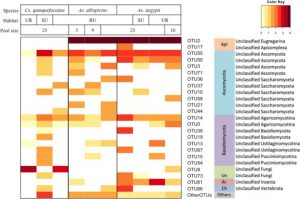Highlight Activities 2021: Mosquito vector-associated microbiota: Metabarcoding bacteria and eukaryotic symbionts across habitat types in Thailand endemic for dengue and other arthropod-borne diseases
Abstract
Vector- borne diseases are a major health burden, yet factors affecting their spread are only partially understood. For example, microbial symbionts can impact mosquito reproduction, survival, and vectorial capacity, and hence affect disease transmission. Nonetheless, current knowledge of mosquito- associated microbial communities is limited. To characterize the bacterial and eukaryotic microbial communities of multiple vector species collected from different habitat types in disease endemic areas, we employed next- generation 454 pyrosequencing of 16S and 18S rRNA amplicon libraries, also known as metabarcoding. We investigated pooled whole adult mosquitoes of three medically important vectors, Aedes aegypti, Ae. albopictus, and Culex quinquefasciatus, collected from different habitats across central Thailand where we previously characterized mosquito diversity. Our results indicate that diversity within the mosquito microbiota is low, with the majority of microbes assigned to one or a few taxa. Two of the most common eukaryotic and bacterial genera recovered (Ascogregarina and Wolbachia, respectively) are known mosquito endosymbionts with potentially parasitic and long evolutionary relationships with their hosts. Patterns of microbial composition and diversity appeared to differ by both vector species and habitat for a given species, although high variability between samples suggests a strong stochastic element to microbiota assembly. In general, our findings suggest that multiple factors, such as habitat condition and mosquito species identity, may influence overall microbial community composition, and thus provide a basis for further investigations into the interactions between vectors, their microbial communities, and human- impacted landscapes that may ultimately affect vector- borne disease risk.
Figure 6: Heatmap showing the composition of mosquito‐associated eukaryotic microbiota. The OTUs with total number of sequence >50 are presented in rows of the heatmap along with their most likely taxonomy. The rest of OTUs were grouped into “Other OTUs” group at the bottom row. The color key on the top right corner indicates the powers of the log‐transformed base 10 of the sequence numbers in the cells. Api, Apicomplexa; Un, Unclassified Fungi; Ar, Arthropoda; Ch, Chordata; RU, rural; SU, suburb; UR, urban
เป้าหมาย 3: สร้างหลักประกันว่าคนมีชีวิตที่มีสุขภาพดีและส่งเสริมสวัสดิภาพสำหรับทุกคนในทุกวัย (Ensure healthy lives and promote well-being for all at all ages) เป้าหมายย่อย 3.b สนับสนุนการวิจัยและการพัฒนาวัคซีนและยาสำหรับโรคติดต่อและไม่ติดต่อที่ส่งผลกระทบโดยตรงต่อประเทศกำลังพัฒนา ให้มีการเข้าถึงยาและวัคซีนจำเป็นในราคาที่สามารถซื้อหาได้ ตามปฏิญญาโดฮาความตกลงว่าด้วยสิทธิในทรัพย์สินทางปัญยาที่เกี่ยวกับการค้าและการสาธารณสุข ซึ่งเน้นย้ำสิทธิสำหรับประเทศกำลังพัฒนาที่จะใช้บทบัญญัติในความตกลงว่าด้วยสิทธิในทรัพย์สินทางปัญญาที่เกี่ยวกับการค้าอย่างเต็มที่ในเรื่องการผ่อนปรนเพื่อจะปกป้องสุขภาพสาธารณะและโดยเฉพาะการเข้าถึงยาโดยถ้วนหน้า
Reference: Thongsripong, P., Chandler, J. A., Green, A. B., Kittayapong, P., Wilcox, B. A., Kapan, D. D., & Bennett, S. N. (2018). Mosquito vector-associated microbiota: Metabarcoding bacteria and eukaryotic symbionts across habitat types in Thailand endemic for dengue and other arthropod-borne diseases. Ecology and Evolution, 8(2), 1352–1368.
Source: https://pubmed.ncbi.nlm.nih.gov/29375803/
https://doi.org/10.1002/ece3.3676


